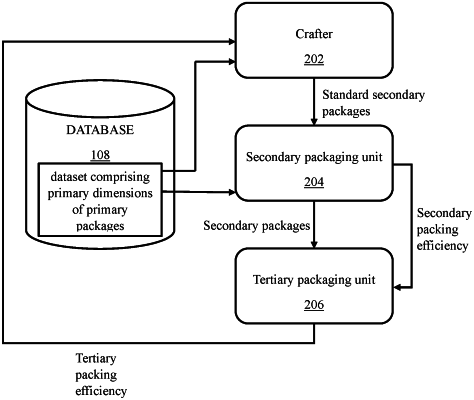| CPC G06N 5/01 (2023.01) [B65B 57/10 (2013.01); B65B 65/08 (2013.01); G06Q 10/04 (2013.01); G06Q 10/08 (2013.01); B65B 2220/16 (2013.01)] | 13 Claims |

|
1. A process implemented method for packing products by online bin packing with increased efficiency across packaging levels, the method comprising:
obtaining, by one or more hardware processors, a dataset comprising primary dimensions of a plurality of primary packages, wherein the primary dimensions include length, breadth, and height of each of the plurality of primary packages;
applying, by the one or more hardware processors, a K-means clustering technique on the primary dimensions of the plurality of primary packages to create a plurality of clusters of the plurality of primary packages, wherein each of the plurality of clusters has a subset of packages from the plurality of primary packages, wherein each of the plurality of clusters is represented by maximum of each of the primary dimensions of the subset of packages within a corresponding cluster among the plurality of clusters, wherein the K-means clustering technique comprises an objective function to minimize sum ratio of volume of each of the subset of primary packages within the corresponding cluster to a standard package representing the corresponding cluster having dimensions equal to maximum of each of the primary dimensions of the subset of packages within the corresponding cluster and achieves a high packing efficiency;
identifying, by the one or more hardware processors, secondary dimensions for a plurality of standard secondary packages for the plurality of clusters, wherein each of the plurality of standard secondary packages is associated with the corresponding cluster and has the secondary dimensions equal to maximum of each of the primary dimensions of the subset of packages within the corresponding cluster, and wherein each of the subset of primary packages within each of the plurality of clusters is packed inside a secondary package having secondary dimensions equal to the standard secondary package of corresponding cluster to generate a plurality of secondary packages, and wherein the secondary dimension of the plurality of secondary packages are identified by dividing a 3-Dimensional space of a tertiary package in such a way that when packed optimally the identified secondary packages perfectly fits within the tertiary package, wherein the secondary dimension of the plurality of secondary packages are identified by:
selecting a final standard secondary package, for each of the plurality of primary packages, among the one or more standard secondary packages identified for each of the plurality of primary packages, wherein the selected final standard secondary package has least volume among the one or more standard secondary packages identified for each of the plurality of primary packages; and
reassigning each of the plurality of primary packages to the cluster corresponding to the selected final standard secondary package;
calculating, by the one or more hardware processors, secondary packing efficiency for each of the plurality of secondary packages, wherein the secondary packing efficiency is calculated as ratio of total volume of the primary package within the secondary package to the volume of corresponding secondary package;
packing, by a robotic arm via the one or more hardware processors, the plurality of secondary packages within one or more tertiary packages using Mixed Integer Linear Programming (MILP) optimization model, wherein the robotic arm picks and places the plurality of secondary packages in the one or more tertiary packages, wherein the MILP comprises an objective function which maximizes space utilization within the one or more tertiary packages, based on a plurality of heuristics and checks a degree of freedom of the robotic arm that is used to place the secondary package within the tertiary package, subject to a plurality of packing constraints comprising geometric constraints, vertical stability constraints, and efficient packing constraints, and wherein the MILP optimization model enables packing by:
iteratively identifying feasible locations for each of the plurality of secondary packages in look-ahead and packing the plurality of secondary packages within suitable tertiary package, if at any point in time, no feasible location for the secondary packages is identified, a tertiary package with maximum tertiary packing efficiency is closed and a new tertiary package is opened for packing remaining secondary packages, wherein the MILP optimization model decomposes a problem of
 -look-ahead into -look-ahead into  problems of 1-look-ahead to reduce the computation time of the MILP optimization model, and wherein the computation time of the MILP optimization model is within a time bound of a robot decision-making operation for picking and placing the plurality of secondary packages in the one or more tertiary packages; and problems of 1-look-ahead to reduce the computation time of the MILP optimization model, and wherein the computation time of the MILP optimization model is within a time bound of a robot decision-making operation for picking and placing the plurality of secondary packages in the one or more tertiary packages; andproviding a feedback between the tertiary package and the secondary packages to identify standard secondary packages which can pack the primary packages with higher packing efficiency;
calculating, by the one or more hardware processors, tertiary packing efficiency for each of the one or more tertiary packages, wherein the tertiary packing efficiency is calculated as ratio of total volume of secondary packages within the tertiary package to volume of corresponding tertiary package;
multiplying, by the one or more hardware processors, an average of the secondary packing efficiency of each of the plurality of secondary packages and an average of the tertiary packing efficiency of each of the one or more tertiary packages to get a product of packing efficiencies; and
selecting, by the one or more hardware processors, the standard secondary packages, and corresponding clusters whose product of packing efficiencies is maximum, wherein the selected standard secondary packages are utilized for packing newly obtained primary packages to achieve increased efficiency across packaging levels.
|